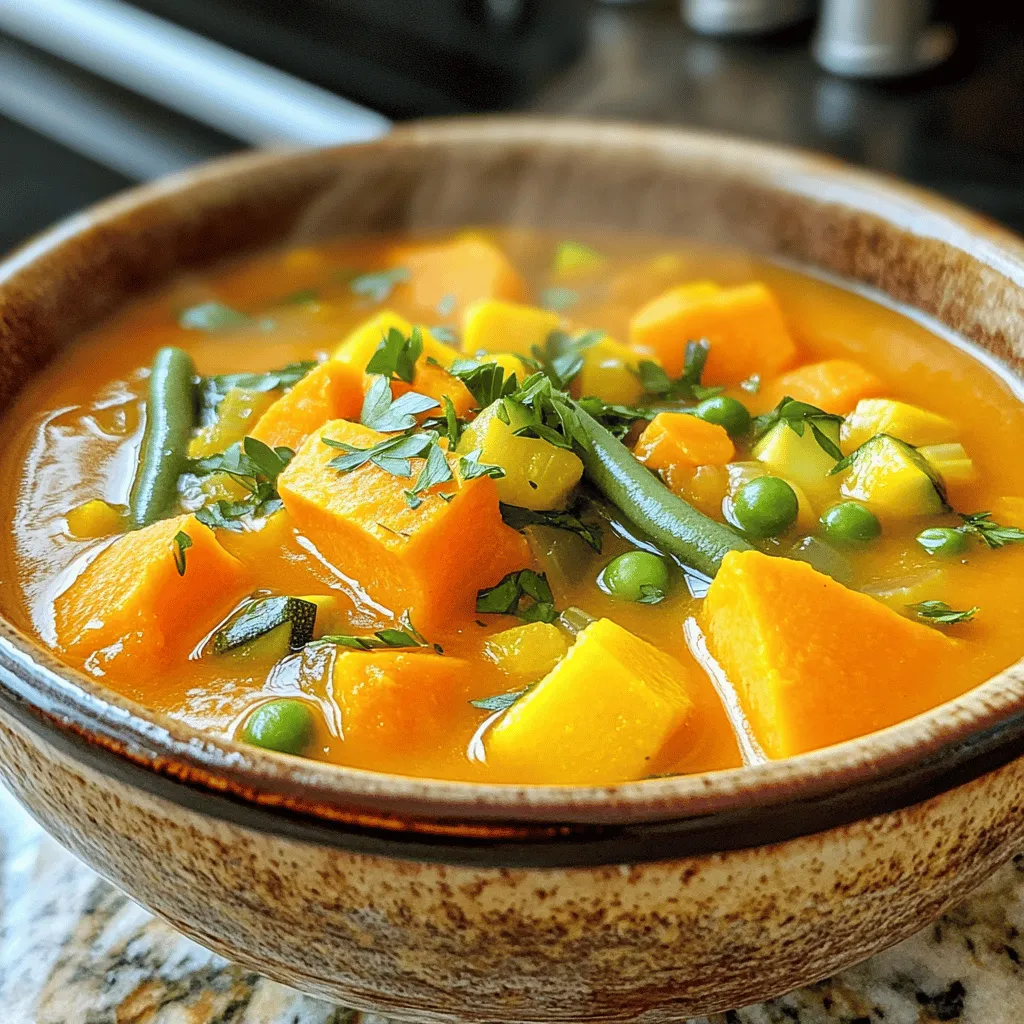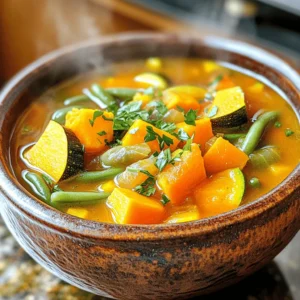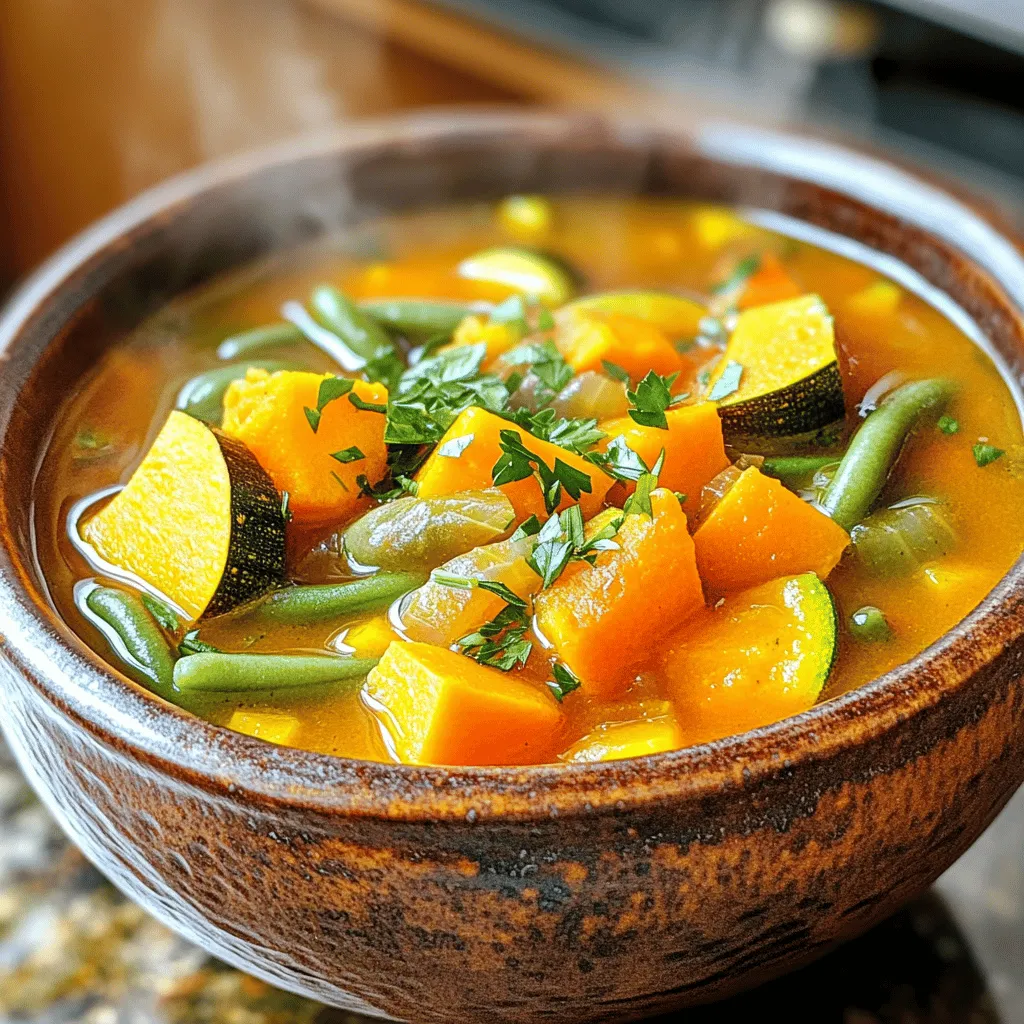As the leaves shift to warm hues and the air turns crisp, there’s nothing like a warm bowl of Fall Harvest Vegetable Soup to embrace the season. This nourishing delight not only warms you up, but also showcases the bounty of fall’s freshest produce. Let’s explore the perfect mix of ingredients, step-by-step instructions, and creative variations to make this soup your new go-to recipe as the days grow shorter. Dive in and savor the flavors of fall!
Ingredients
Complete List of Ingredients
This soup uses fresh, healthy ingredients that shine in the fall.
– 1 tablespoon olive oil
– 1 medium onion, diced
– 2 cloves garlic, minced
– 2 medium carrots, diced
– 2 stalks celery, diced
– 1 medium sweet potato, peeled and cubed
– 1 cup butternut squash, cubed
– 1 cup green beans, trimmed and cut into 1-inch pieces
– 1 zucchini, diced
– 1 can (14 oz) diced tomatoes
– 4 cups vegetable broth
– 1 teaspoon dried thyme
– 1 teaspoon ground cumin
– Salt and pepper to taste
– Fresh parsley or basil for garnish
Each ingredient brings unique benefits to the table.
– Olive oil adds healthy fats and flavor.
– Onion and garlic boost heart health and add depth.
– Carrots provide beta-carotene for good vision.
– Celery helps hydration and has low calories.
– Sweet potato offers fiber and vitamins A and C.
– Butternut squash is rich in antioxidants and potassium.
– Green beans are low in calories and full of vitamins.
– Zucchini adds hydration and is high in vitamin C.
– Diced tomatoes are packed with lycopene, good for the heart.
– Vegetable broth is low in calories and adds flavor.
– Thyme and cumin provide flavor and health benefits too.
These ingredients are easy to find in fall. Look for squash, sweet potatoes, and beans at local farmers’ markets. Fresh herbs may be available too, adding a lovely touch to your soup.
This soup is not just comforting but also nourishing. You can find the full recipe in the article.
Step-by-Step Instructions
Preparation Process
To make your Fall Harvest Vegetable Soup, start by gathering all your ingredients. This will save you time later. Here’s how to chop and prep the veggies efficiently:
– Onion: Dice it small. This helps it cook faster and blend with other flavors.
– Garlic: Mince it finely for strong flavor.
– Carrots & Celery: Cut them into small, even pieces. This ensures they cook at the same rate.
– Sweet Potato & Butternut Squash: Peel and cube them. Aim for 1-inch pieces for quick cooking.
– Green Beans: Trim the ends and cut into 1-inch pieces.
– Zucchini: Dice it into small pieces to add texture.
The order of adding ingredients is key. Start with onion and garlic, then add the root veggies, and finally the softer ones. This helps build layers of flavor.
Cooking Method
For the best results, use a large pot or Dutch oven. These retain heat well. Set your stove to medium heat.
– Heat the olive oil: Wait until it shimmers, then add the onion.
– Cook time: The total time is about 45 minutes. Once the soup boils, lower heat and let it simmer for 20-25 minutes.
– Signs your soup is done: Check the veggies. They should be tender but not mushy. A taste test is the best way to know if it’s ready.
Follow these steps for a warm, comforting bowl of soup that truly captures the essence of fall. For the full recipe, check the earlier section.
Tips & Tricks
Cooking Tips
– How to enhance flavor with spices and herbs: Adding dried thyme and ground cumin gives your soup depth. Fresh herbs like parsley or basil add brightness. Feel free to experiment with your favorites.
– Techniques for a creamier texture (if desired): To create a creamy feel, blend a portion of the soup after cooking. You can use an immersion blender or a regular blender. This adds richness without heavy cream.
– Using leftover vegetables effectively: Don’t toss old veggies! Dice them and toss into your soup. This minimizes waste and adds unique flavors. Just chop them small, so they cook evenly.
Common Mistakes to Avoid
– Overcooking vegetables: Cooking too long makes veggies mushy. Aim for tender but firm. Check regularly to keep their color and crunch.
– Not seasoning adequately during cooking: Season in layers. Add salt and pepper at different steps to build flavor. A little taste test along the way helps too.
– Skipping the sautéing step: Sautéing onion and garlic first is key. This step builds a flavor base. Don’t rush it; let them soften before adding other ingredients.
For the full recipe, check the detailed steps to create this comforting soup.

Variations
Ingredient Swaps
You can change up the vegetables in this soup based on what you like or have. Try using:
– Sweet potatoes instead of regular potatoes
– Kale or spinach for extra greens
– Bell peppers for a pop of color
You can also add protein to make it heartier. Great options include:
– Canned beans like chickpeas or kidney beans
– Lentils for a boost of fiber
– Shredded chicken or turkey for meat lovers
If you want a vegan or gluten-free soup, stick with beans and veggies. Use a gluten-free broth to keep it safe for all diets.
Flavor Profile Variations
To spice things up, you might want to add some heat. Consider:
– A pinch of red pepper flakes
– Diced jalapeños for a kick
If you love herbs, try these:
– Fresh thyme or rosemary for depth
– Basil for a sweet note
For a creamy twist, blend a portion of the soup and return it to the pot. You can also add a splash of coconut milk for richness.
Feeling adventurous? Try an Asian-inspired version. Add:
– Miso for a savory depth
– Fresh ginger to brighten the flavors
These variations make the soup exciting and perfect for any palate. Check out the Full Recipe to see how you can mix and match flavors!
Storage Info
Storing Leftovers
To store your Fall Harvest Vegetable Soup, let it cool first. Transfer the soup to airtight containers. You can keep it in the fridge for up to four days. If you want to save it longer, freeze it. Use freezer-safe bags or containers. This way, you can enjoy it later without losing flavor.
When you reheat your soup, do it gently. Use a pot on low heat. Stir often to keep it smooth. If it seems too thick, add a splash of broth or water. This will help restore the texture.
The soup’s shelf life is about four days in the fridge and up to three months in the freezer. Always check for any off smells or changes in color before eating leftovers.
Meal Prep Ideas
Freezing soup in portions is a smart move. Use small containers or freezer bags. This makes it easy to grab a single serving for lunch or dinner. Just remember to label the bags with dates.
If you have a busy week ahead, make the soup on the weekend. You can have warm meals ready in no time. Just reheat as needed.
You can also use this soup in other dishes. Try adding it to pasta or grain salads for a health boost. You can even blend it into a sauce for a new twist on your favorite pasta dish. For more ideas, check out the Full Recipe for inspiration.
FAQs
Common Questions
What can I substitute for vegetable broth?
You can use water with a bit of seasoning. Add herbs like thyme or bay leaf. Another option is to use chicken broth if you are not vegetarian. This adds a nice depth of flavor to the soup.
How can I make this soup spicier?
To add heat, sprinkle in some red pepper flakes or a dash of hot sauce. You can also add diced jalapeños or serrano peppers for a fresh kick. Start small and taste as you go to reach your desired spice level.
Can I use frozen vegetables in this recipe?
Yes, frozen vegetables work well! Just make sure to thaw them first. This can save time and still give you a tasty soup. They may also add a nice texture and flavor to your Fall Harvest Vegetable Soup.
Serving Suggestions
Recommended sides to pair with the soup
Pair this soup with crusty bread or a fresh salad. A warm piece of sourdough is perfect for dipping. You can also serve it with a light cheese platter for variety.
Presentation tips for serving
Serve the soup in a deep bowl for a cozy feel. Use a ladle to pour it gently. You can also add a drizzle of olive oil on top for an elegant touch.
Ideal garnishes to enhance flavor and look
Chop fresh parsley or basil for a pop of color. You can also use a sprinkle of grated cheese. A few croutons add crunch and look nice too.
Nutritional Information
Caloric breakdown of a serving
One serving has about 150 calories. This varies with ingredients, but it’s a healthy choice. It’s packed with nutrients and low in calories.
Health benefits of seasonal vegetables
Seasonal vegetables boost your immune system. They provide vitamins, minerals, and antioxidants. Eating them can help you stay healthy during the colder months.
Dietary information for common allergies
This soup is naturally vegan and gluten-free. Always check labels on canned tomatoes for gluten. For nut allergies, ensure your broth is nut-free.
In this article, we explored how to make a delicious Fall Harvest Vegetable Soup. We reviewed the important ingredients, their nutrients, and how to prep them. The step-by-step instructions make cooking simple, while our tips help you avoid common mistakes. You also learned about variations to suit your taste. Lastly, we discussed storage and meal prep options for easy future meals. Enjoying this soup can bring warmth and healthy choices to your fall days. Dive into your cooking, and have fun experimenting with flavors!

